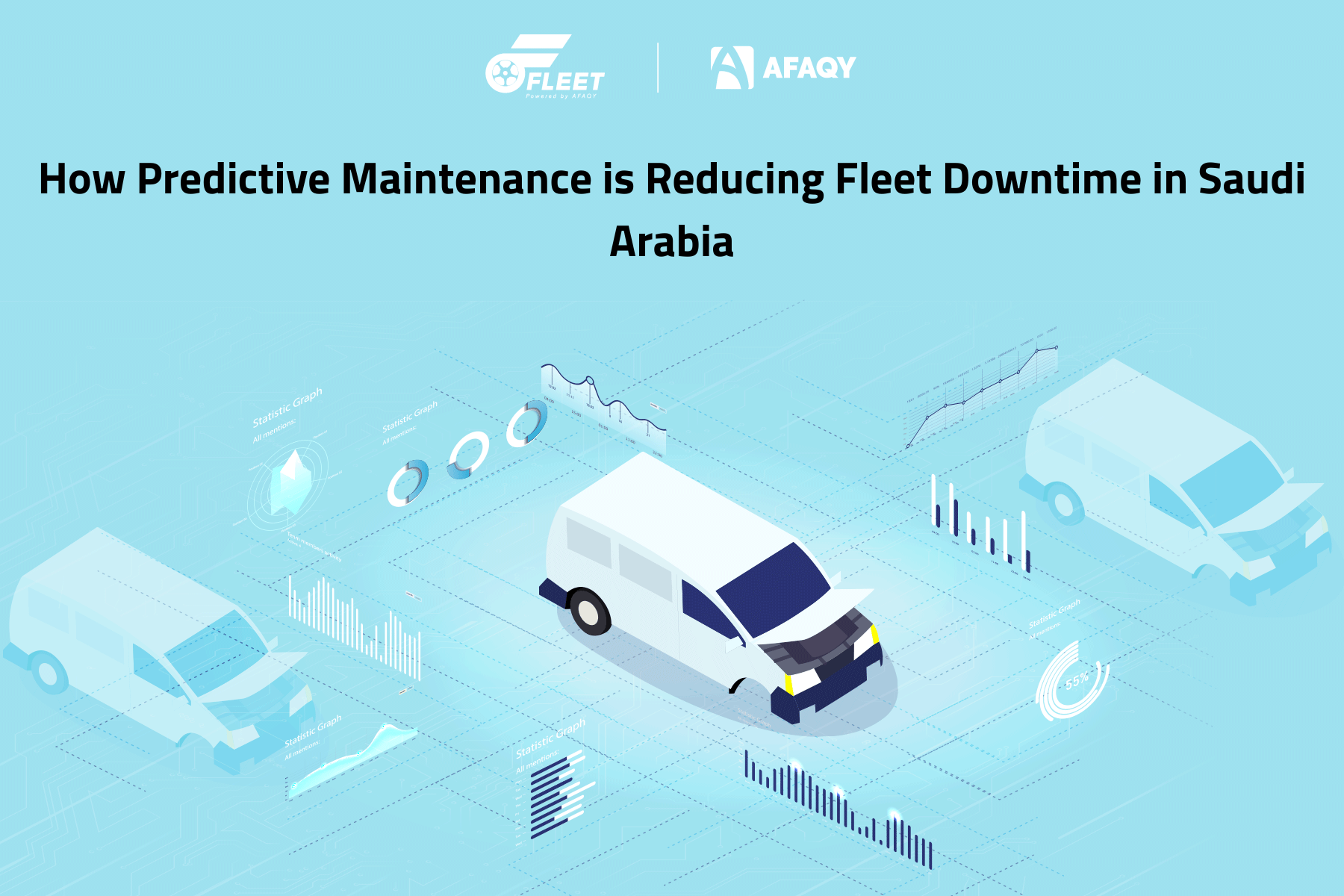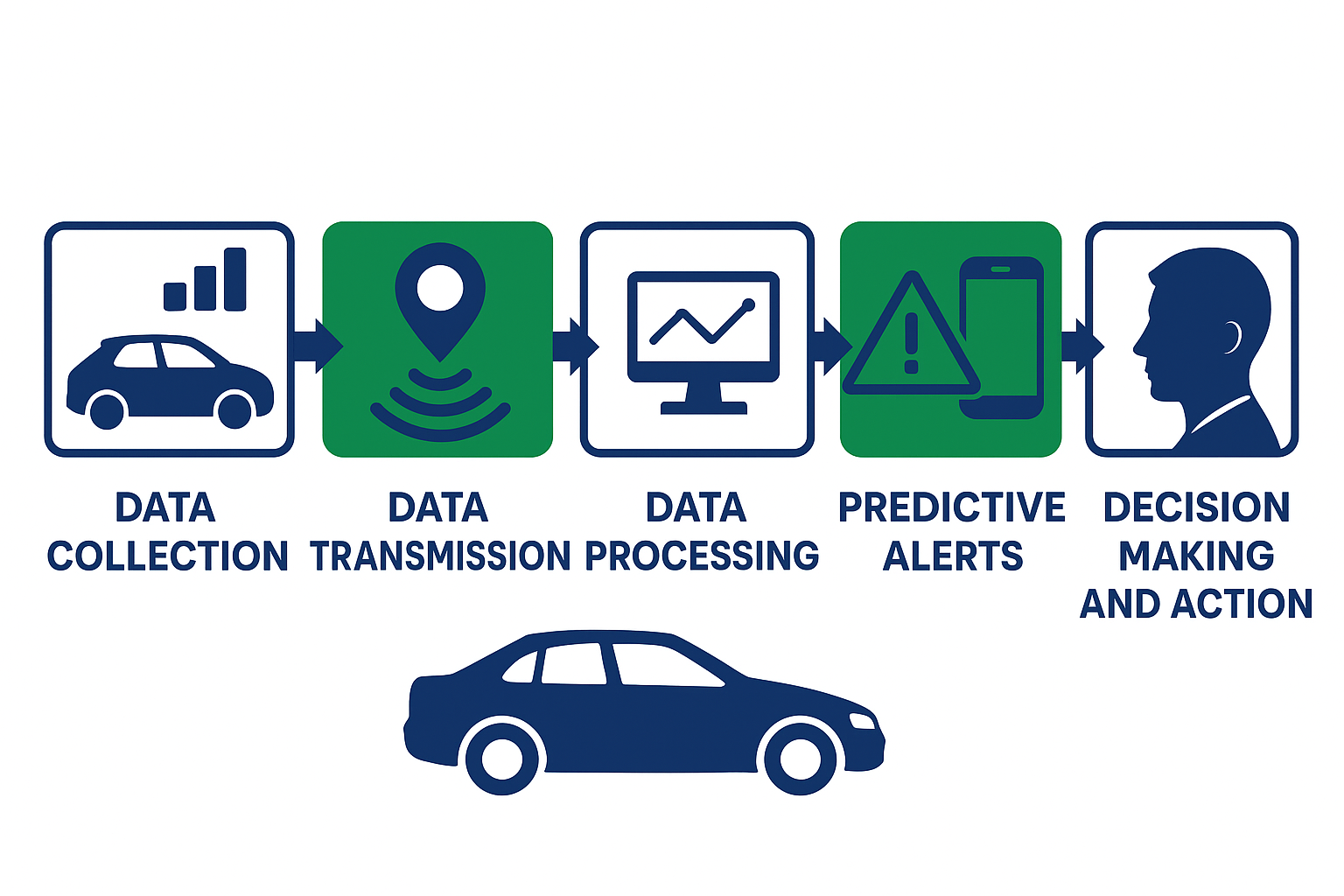How Predictive Maintenance is Reducing Fleet Downtime in Saudi Arabia

How Predictive Maintenance is Reducing Fleet Downtime in Saudi Arabia
Still depending on traditional maintenance methods to maintain your fleet health? As a fleet manager or owner, you've likely faced unexpected breakdowns, safety issues, and rising repair costs. While preventive maintenance follows set schedules, it often results in unnecessary repairs, especially when not all vehicles require servicing at the same time.
Today, there's a growing need for a smarter, more cost-effective approach to fleet upkeep. Thanks to advancements in IoT and AI, predictive maintenance has emerged as a powerful solution. Unlike routine schedules, this data-driven method monitors vehicle health in real time and anticipates issues before they happen.
According to Mckinsey.com, this proactive approach can reduce fleet maintenance costs by up to 25%. With its data analytics features that leverage telematics data in real-time to provide you with insights into vehicles’ conditions, you can prevent any potential issues before they escalate, cut operational costs, and boost overall efficiency.
In this blog post, we’ll define predictive maintenance in fleets, explain how it works, and its role in reducing fleet downtime in Saudi Arabia. Let’s dig deeper!
Table of Contents
· What Is Predictive Maintenance in Fleet Management?
· How Does It Work?
· Preventive Vs. Predictive Maintenance. What Is the Difference?
· The Key Technologies Behind Predictive Maintenance in Smart Fleet Monitoring
· The Top Benefits of Fleet Predictive Maintenance in Saudi Arabia
· Future-proof Your Fleet Today with AFAQY’s Fleet Management System
What Is Predictive Maintenance in Fleet Management?
.jpg)
Predictive maintenance is an indispensable feature in any fleet management system that leverages advanced technologies such as artificial intelligence, internet of things, and telematics data to predict any possible vehicle repairs before they become big problems.
It analyses vast amounts of real-time data and turns them into valuable insights that are transmitted to you through the fleet dashboard to identify the vehicles that need repairs along with equipment failures.
Unlike other maintenance methods that focus on routine checks such as preventive or reactive, the predictive maintenance feature allows for a proactive approach that helps you focus only on the vehicles that have problems, preventing any unnecessary repair costs and enhancing your operational efficiency.
How Does It Work?
The predictive maintenance feature collects fleet real-time and historical data to check maintenance KPIs such as engine temperature, tire pressure, fuel usage, brake conditions, and driver behavior.
Advanced analytics and machine learning algorithms analyze this data to detect patterns, anomalies, and early signs of component wear or potential failures.
Here is how Predictive maintenance works step-by-step:
· Data Collection: The feature gathers real-time and historical data from various sensors, GPS devices, and driver behavior analysis tools. These may include data about fuel usage, braking performance, and engine temperature.
· Data Transmission: Collected data is securely transmitted, often via cellular or satellite networks, to a central fleet management platform. This transmission ensures that even vehicles on the road or in remote locations can continuously send condition updates to cloud-based analytics systems.
· Data Processing: The data is then automatically filtered and analyzed to extract only the features that are relevant to maintenance needs such as mileage, temperature, brakes, fuel usage, and equipment performance.
· Predictive Alerts: The system generates maintenance alerts and recommendations when a component shows early signs of wear or malfunction, giving fleet managers the ability to proactively intervene before expensive or dangerous breakdowns occur.
· Decision Making and Action: Fleet managers utilize insights from predictive alerts to schedule maintenance at optimal times, minimizing downtime and maximizing vehicle utilization.

Preventive Vs. Predictive Maintenance. What Is the Difference?
When it comes to preventive maintenance, we talk about fixed repair schedules and routine checks such as oil changes, tire rotations, and brake inspections. This approach aims at servicing components at regular intervals. For instance, a fleet manager may schedule an oil change for all delivery vans every 5,000 miles, even if the oil still appears to be in good condition.
On the other hand, integrating predictive maintenance into fleet management operations hits a balance between routine measures and data-driven decision making to identify early warning signs and avoid unnecessary repairing costs.
Predictive maintenance focuses on real-time data and predictive analytics in fleet management to determine the actual condition of a vehicle and predict when maintenance is needed. It relies on data extracted from sensors, telematics, and fleet diagnostics.
This approach allows maintenance to be performed only when necessary, increasing operational efficiency. Its primary goal is to minimize unnecessary maintenance and maximize the lifespan of fleet assets.
The Key Technologies Behind Predictive Maintenance in Smart Fleet Monitoring
.jpg)
To understand predictive maintenance more, we must first understand the key technologies that drive this proactive approach. These technologies play a major role in increasing vehicles’ uptime by providing fleet managers with data-driven and real-time insights that enhance the decision-making process and keep them proactive to any malfunctions.
Let’s highlight some of these technologies:
Telematics Maintenance Alerts
These systems gather real-time data from vehicles, including metrics like engine performance, fuel consumption, location, speed, and idling time. This data provides valuable insights and maintenance alerts into how a vehicle is being used and its current condition.
IoT (Internet of Things)
IoT sensors that are embedded in various vehicle systems such as the engine, brakes, tires, and transmission continuously monitor parameters like temperature, vibration, fluid levels, and pressure. By capturing this real-time data, fleet managers can detect abnormal patterns that may indicate potential issues.
Onboard diagnostics systems (OBD-II)
These are standard in most modern vehicles and are capable of reporting fault codes and vehicle performance data. When combined with IoT sensors and telematics, OBD-II systems contribute to a comprehensive view of vehicle health.
Artificial Intelligence (AI) and Machine Learning (ML)
These algorithms analyze historical and current data to identify patterns and predict when specific components are likely to fail. Over time, these models improve in accuracy, making the system smarter and more efficient at anticipating maintenance needs.
Cloud Computing and Data Analytics
This is also a very crucial component as it enables the storage, processing, and visualization of large volumes of vehicle data. Fleet managers can access dashboards and reports that summarize vehicle conditions, performance trends, and recommended actions, helping them make informed maintenance decisions.
The Top Benefits of Fleet Predictive Maintenance in Saudi Arabia
As oil and gasoline prices continue to rise, utilizing cutting-edge technologies to reduce vehicle wear and tear, oil consumption, and the costs associated with vehicle accidents has become inevitable.
Fleet predictive maintenance in Saudi Arabia offers a game-changing solution for fleet managers to anticipate malfunctions and breakdowns before they occur, minimizing operational delays.
This approach supports the goals of Vision 2030 by advancing fleet modernization, enhancing transport efficiency, and promoting the adoption of smart technologies across the Kingdom’s logistics and mobility sectors.
Here are some of the lucrative benefits that predictive maintenance brings to the table:
Eliminated Vehicle Sudden Breakdowns
By analyzing vast amounts of the data generated from telematics systems and IoT sensors, predictive maintenance can give warning signs of upcoming breakdowns so that fleet managers can respond proactively.
This plays a crucial role in increasing vehicle uptime and maximizing their availability. This way you can accelerate delivery deadlines, boost productivity, and increase customer satisfaction.
Reduced Repair Costs
Predictive maintenance helps you detect minor problems before they become major failures. It enables you to schedule maintenance during off-peak hours or when vehicles are not in use to minimize operational disruptions and reduce the costly consequences associated with excessive downtime.
Enhanced Fuel Efficiency
Vehicle malfunctions are one of the main reasons behind increasing fuel consumption. Problems such as underinflated or misaligned tires increase rolling resistance, forcing the engine to work harder and burn more fuel.
Also, using the wrong grade of engine oil or neglecting oil changes can increase engine friction, making the engine less efficient and more fuel hungry.
Predictive maintenance identifies such problems early, allowing for timely repairs and vehicle checks.
Improved Compliance & Safety through Predictive Maintenance
According to the National Highway Traffic Safety Administration (NHTSA), around 45,000 accidents per year happen due to vehicle malfunctions.
Also, inadequate vehicle maintenance is linked to around 2,600 fatalities and 100,000 serious injuries annually, resulting in nearly $2 billion in losses from medical costs, lost wages, and property damage.
Deflated tires or worn brakes can lead to serious consequences. By preventing failures before they occur, predictive maintenance ensures the safety of your fleets and drivers. Additionally, it helps you stay compliant with Saudi Arabia’s vehicle maintenance regulations that prioritize road safety, environmental protection, and vehicle longevity.
Future-proof Your Fleet Today with AFAQY’s Fleet Management System
Fleet is a powerful solution designed by AFAQY to drive operational efficiency through intelligent, predictive maintenance. With advanced features that go beyond basic service tracking, our smart solution empowers your team to record and monitor every maintenance activity, automate recurring service plans, and gain complete visibility into vehicle health.
Whether you're managing a handful of vehicles or a large-scale operation, the platform delivers actionable insights, historical traceability, and mileage- or time-based triggers that ensure timely interventions before issues arise.
Predict failures, streamline workshop workflows, and standardize service definitions, all from a single, intuitive system. Contact Us today!
FAQs
1. How to Reduce Fleet Downtime with Predictive Maintenance?
Predictive maintenance reduces fleet downtime by identifying potential issues before they turn into major failures.
By using real-time data from vehicle sensors and fleet diagnostics, fleet managers can schedule repairs during off-peak hours and address minor problems early. This minimizes unexpected breakdowns, keeps vehicles in service longer, and improves overall fleet availability.
2. How Does IoT Help Prevent Vehicle Breakdowns?
IoT (Internet of Things) enables continuous monitoring of critical vehicle systems through connected sensors. These sensors track parameters such as engine temperature, tire pressure, oil quality, and battery health.
When anomalies are detected, alerts are sent to fleet managers, allowing for timely maintenance and avoiding sudden breakdowns. IoT turns reactive repairs into proactive management.
3. What are the benefits of predictive maintenance for truck fleets?
For truck fleets, predictive maintenance improves operational efficiency, safety, and cost savings. It minimizes unplanned downtime, extends vehicle lifespan, reduces fuel consumption, and leads to maintenance cost reduction.
Predictive insights also help with compliance, as well-maintained trucks are more likely to pass inspections and meet regulatory standards.
4. What Are the best predictive maintenance tools for fleets in Saudi Arabia?
The best predictive maintenance tools for fleets in Saudi Arabia are those that combine real-time vehicle monitoring, automated service scheduling, and comprehensive maintenance tracking.
These tools typically integrate with telematics and IoT systems to collect data from sensors installed in vehicles, allowing fleet managers to detect early signs of wear, trigger alerts based on mileage or time thresholds, and prevent unexpected breakdowns.
For fleets operating in Saudi Arabia, it's essential that the tools support Arabic language, local compliance requirements, and offer cloud-based access for remote fleet management.
References
1. Giannoulidis, A., Michailidou, A., Toliopoulos, T., Constantinou, I., & Gounaris, A. (2024).Predictive maintenance in a fleet management system: the Navarchos case. In Lecture notes in business information processing (pp. 111–119).https://doi.org/10.1007/978-3-031-61000-4_13
2. Nalla, N. N. R.(2025). Predictive maintenance in Fleet Management: Analyzing audio data forhazard detection. Deleted Journal, 21(1s), 132–136.https://doi.org/10.52783/jes.8362
3. Hansley, P. (2024,September 25). How to Optimize Fleet Management with Predictive Analytics. Tech Research Online.https://techresearchonline.com/blog/how-to-optimize-fleet-management-with-predictive-analytics/



































.png)


